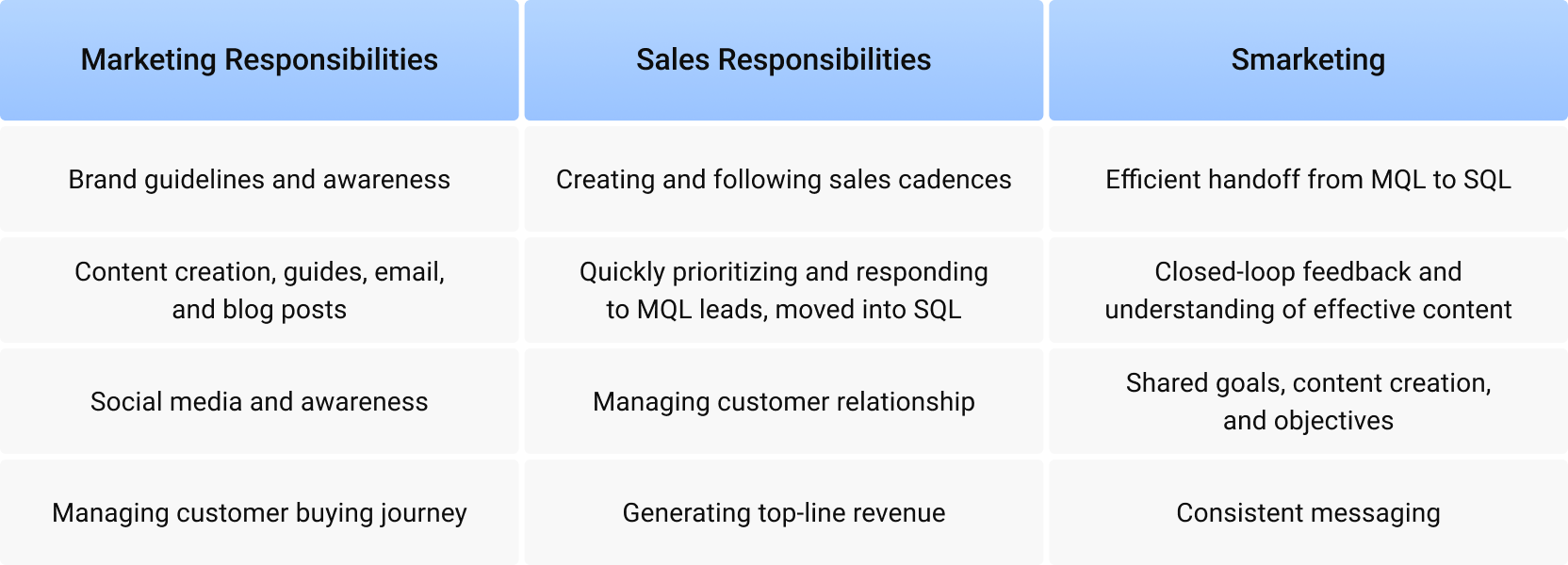Upgrade Your Team With Sales and Marketing Alignment
Alignment between marketing and sales is crucial for organizations that want to drive success in a rapidly changing, customer-centric sales environment. This guide provides tips to align your marketing and sales teams, providing a unified message that resonates with prospects throughout the customer journey.
What is marketing and sales alignment?
It’s not as complicated as it sounds - fundamentally, it means that your marketing and sales departments are working together toward a common goal of selling to the best-qualified prospects. The path to that goal should be a positive, seamless experience for your customers.

Why are marketing and sales alignment so critical to the success of your organization?
It’s necessary to align your teams and create a unified message from the first touch, sales contact, and even post-sale.
Imagine a potential customer looking for solar panel installation. There are many different solar companies to choose from; why does a prospect choose a specific company? A common and compelling reason is referral by someone they know and trust. Referral leads are acting on social proof from one or more trusted sources.
Learn more about social proof and going viral.
Now, let’s say that prospect is at dinner with a friend, and the friend says:
“You gotta look into solar, not only are we saving on our electric bill, it’s always the same, and we are doing our part for the environment.”
The next question from the prospect might be something like: “Ok, but what about the process? It seems like a lot; what if they mess up our roof… I bet they do a bit of bait and switch. Are you really saving money?”
The friend responds with: “The solar company I used was awesome, their sales team made a preliminary discovery of our home, made sure there would be savings, and the sales department was correct; we got a flyer in the mail about the potential savings, and they delivered on that promise.”
The prospect has an expectation set by someone they trust: they’ll have an “awesome” experience by selecting this particular solar provider.
Now, imagine for a second that instead, the initial flyer received said they would save 20% on their electric bill, and then the sales team uncovered they could only save 10%. Then even worse, they experienced all kinds of problems with getting ahold of support to fix some installation issues. This inconsistency can kill a company, which happens when sales and marketing are not aligned.
What is the role of marketing in the sales process?
For marketing and sales alignment to work, leadership in these departments needs to understand that this is a unified team. A team that needs to rely on one another for feedback, refinement, improvement, and to hold each other accountable. Marketing has a very specific role in the sales process and vice versa.
Marketing supports the sales team by
- Continually working on customer education through white papers, flyers, case studies, and all customer-facing documentation.
- Creating lead nurture programs that score prospects and qualify them as MQLs (Marketing Qualified Leads) for the sales team. Additionally, marketing can nurture lost sales prospects and create multiple nurture streams based on sales outcomes.
- Assisting with sales cadences; this includes all email, text, or phone communications. You want to make sure the messaging used by sales is consistent with customer-facing messaging designed by the marketing team.
The sales team should assist the marketing team by
1. Content Feedback - Providing feedback on the content used in the prospecting and lead follow-up process.
2. Process Efficiency - Helping marketing to understand roadblocks or pains in the prospecting and sales pitch process.
3. Customer Satisfaction - Relay existing customer satisfaction and readiness for potential opportunities like reporting when it’s the right time to ask for a review.
What problems can marketing and sales solve that can provide tangible benefits to your company?
1. Underutilized content
You can’t fix what you don’t know is broken. Marketing needs to understand what content is resonating with potential prospects. Marketing can use tools like Hubspot and others to track content effectiveness, but feedback from salespeople is critical in the iteration and creative process. Marketing metrics only tell part of the story. Content can miss the mark for reasons the marketing team cannot see in a report.
2. Speed to Lead
It’s more critical than ever for marketing and sales to work together to prioritize immediate contact for prospects based on lead scoring. It’s critical that sales and marketing communicate to determine the ideal time and message for each prospect at various stages of the customer journey.
3. Poor lead data and intelligence
For marketing to understand what leads are working, they need timely updates. Sales and marketing teams can convey urgency by meeting regularly. With proper alignment, leadership can relay data points that help refine lead prioritization rules that benefit sales.
4. Inability to show lead performance ROI
Nothing is more important than sales and marketing working together on reports that show lead cost, the cost to acquire a prospect and ROI from leads. Marketing spends a great deal of budget on leads, and to make quick changes to improve lead quality, they rely on information from the sales team. By aligning sales and marketing, the onus is on both to work together to illustrate ROI in meaningful reports that everyone on the executive team can understand.

How do I get marketing and sales to work together?
- Be transparent - with savings, discounts, ROI, service level commitments, and anything that has to do with price. If you aren’t transparent with any of these commitments, the customer will lose trust. Once trust is lost, it is tough to reclaim.
- Encourage a helpful mindset across your sales and post-sales teams. Make being helpful a top priority over closing business. If your sales team is helpful rather than pushy, they will easily align with the marketing team’s effort to paint your company in the best light possible.
- Conduct joint meetings - have your marketing and sales team leaders conduct joint meetings weekly. Marketing should have multiple opportunities to hear from sales feedback on content, blog posts, messaging, and what is effective and what is not.
- Talk about lead handoff - If marketing is responsible for MQL (Marketing Qualified Leads) and sales are responsible for SQL (Sales Qualified Leads), make sure they meet weekly to discuss qualification criteria, personas, and success rates.
In the end, it is not hard to make a case for marketing and sales to work together. All it takes is helping them both understand that it is in their best interest to work towards common goals. Modern teams cannot afford to be miss-aligned because the ROI is too great and the case too easily made for both to work together. It should be easy to get buy-in from your sales and marketing leaders by outlining the benefits.
See also: Marketing and Sales Alignment




